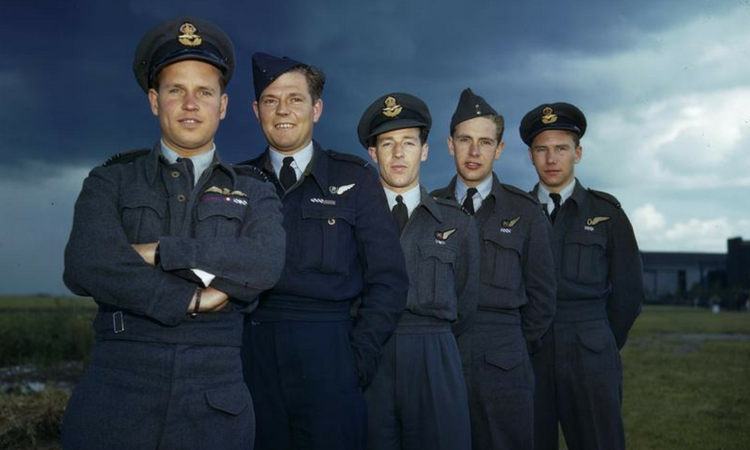16 May 2018
10 things you need to know about the Dambusters

Wing Commander Guy Gibson and his crew board their Avro Lancaster A3-G (ED 932/G) for the dams' raid. © IWM (CH 18005)
Today marks the 75th anniversary of Operation Chastise, better known as the Dambusters Raid – one of the most audacious and technically difficult bombing operations of the Second World War.
- On the night of 16-17 May 1943, 19 Lancaster bombers of 617 Squadron launched a daring raid into Germany. Their targets were three dams in the Ruhr valley, the destruction of which, it was hoped, would cause havoc in Germany’s industrial heartland.
- For the raid a specially devised “Bouncing Bomb” had been created by the inventor Barnes Wallace. This bomb would skip over water, like a skimmed stone, bouncing over protective torpedo nets to hit the dams, then sink and explode.
- 617 Squadron was specially formed for the raid in March 1943 at RAF Scampton in Lincolnshire, and consisted of airman from Britain, Australia, Canadian and New Zealand as well as Americans serving in the Commonwealth air forces.
- The first 19 Lancasters took off from RAF Scampton at 21:28 on 16 May, with the squadron suffering its first casualties soon after. While flying over the Dutch coast, one plane was shot down, while another stuck an electricity pylon and crashed.
- The first target was the Möhne Dam. Wing Commander Guy Gibson made the first attack, but his bomb exploded short. After the second attacking aircraft was shot down, Guy flew along the dam to draw German fire. For this actions Guy was later awarded the Victoria Cross. The Möhne Dam was finally breached on the fifth attack.
- The second target was Eder Dam. This was breached on the fourth attempt and being less well defended was done so without loss.
- The Sorpe Dam was the third target, but was only hit by two bombs and the earthen construction of this dam proved harder to breach. A fourth dam the Ennepe, a secondary target was also attacked but the single bomb failed to breach the dam.
- As a result of the breach of the Möhne and Eder dams German industry in the Ruhr Valley was disrupted, but the dams were soon repaired. Some 1,300 people were killed in the resulting flooding, the majority of them civilians and prisoners of war.
- The daring and skilful nature of the raid had a significant propaganda value, and the raid entered into British popular legend. It was later immortalised in the 1955 film The Dam Busters.
- Eight aircraft were lost during the raid and 53 Commonwealth airmen killed. Twenty-seven are buried in CWGC Reichswald Forest War Cemetery, and a further 21 in Bergen General Cemetery, CWGC Bergen-op-Zoom War Cemetery, CWGC Rheinberg War Cemetery and Harlingen General Cemetery. Six of the airmen were never found, and are commemorated on the CWGC Runnymede Memorial to the missing, in the UK.
Wing Commander Guy Gibson VC, DSO and Bar, DFC and Bar
Guy Gibson was born in India in August 1918, but moved to England with his mother aged six when his parents separated. From a young age guy was interested in flying.
He joined the RAF in 1936, and at the outbreak of war had reached the rank of Flying Officer. By March 1941, Guy was a Wing Commander and a highly experienced officer having flown over 170 sorties with Bomber Command, Coastal Command and a night-fighter squadron. He had been also been awarded the Distinguished Service Order (DSO) and the Distinguished Flying Cross (DFC) and Bar.
In March 1943, Guy was selected to train and lead the newly-formed 617 squadron for Operation Chastise. For his leadership and courage during the operation he received the Victoria Cross.
Following the success of Operation Chastise, the King and Queen inspected Guy and 617 Squadron on 27 May. In June, Guy and all the other newly decorated members of 617 Squadron attended an investiture at Buckingham Palace, were the Queen presented Guy with his VC and the Bar to his DSO. In August, Guy set off on a publicity tour of Canada and the USA, returning in December.
Guy was put on restricted duties and ordered to write a book Enemy Coast Ahead about his wartime experiences. In August 1944, he was posted to RAF Coningsby. On the night of 19/20 September, Guy and his navigator Squadron Leader James Warwick were killed when their plane crashed near Steenbergen in the Netherlands after carrying out a bombing raid on the German town of Bremen. The local Dutch civilians organised a funeral for the two men, and they were laid to rest in Steenbergen-en-Kruisland Roman Catholic Cemetery.

Wing Commander Guy Gibson with members of his crew. Left to right: Wing Commander Guy Gibson, VC, DSO and Bar, DFC and Bar; Pilot Officer P M Spafford, bomb aimer; Flight Lieutenant R E G Hutchinson, wireless operator; Pilot Officer G A Deering and Flying Officer H T Taerum, gunners. © IWM (TR 1127)

